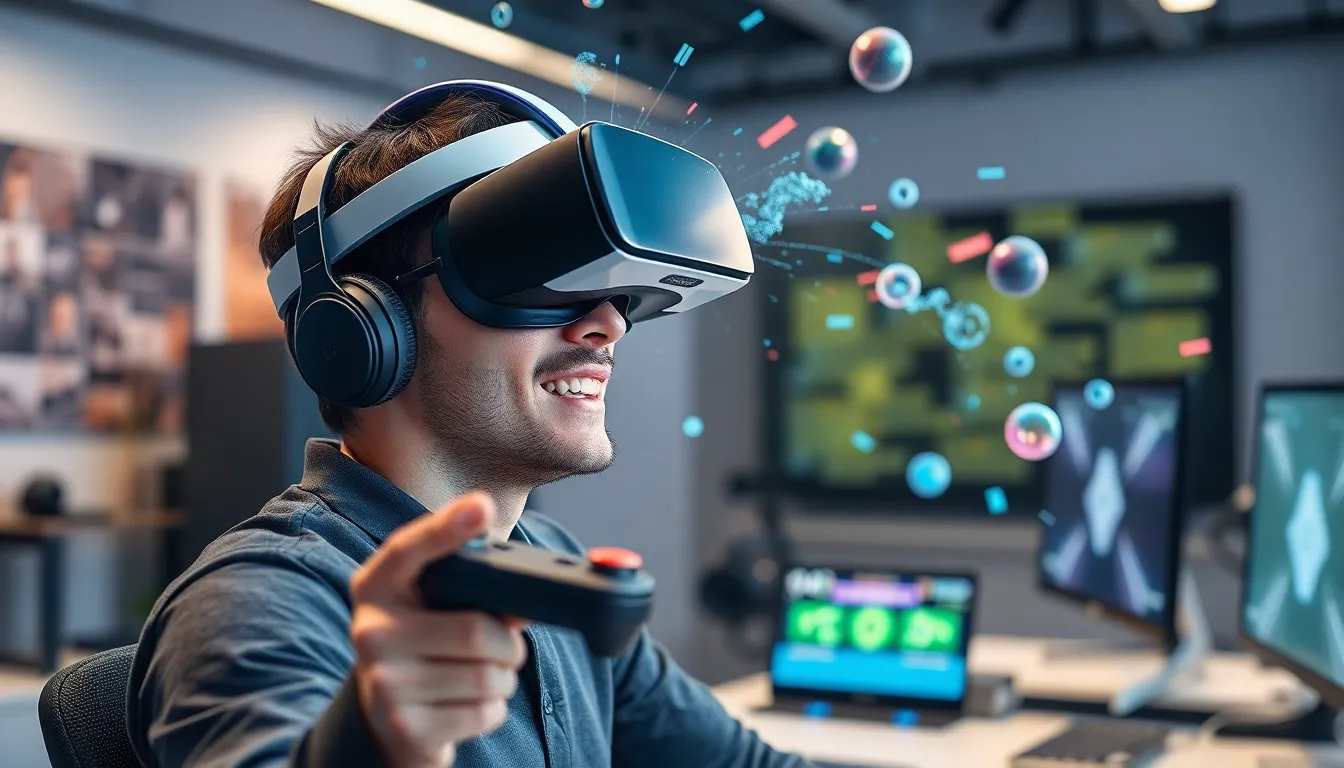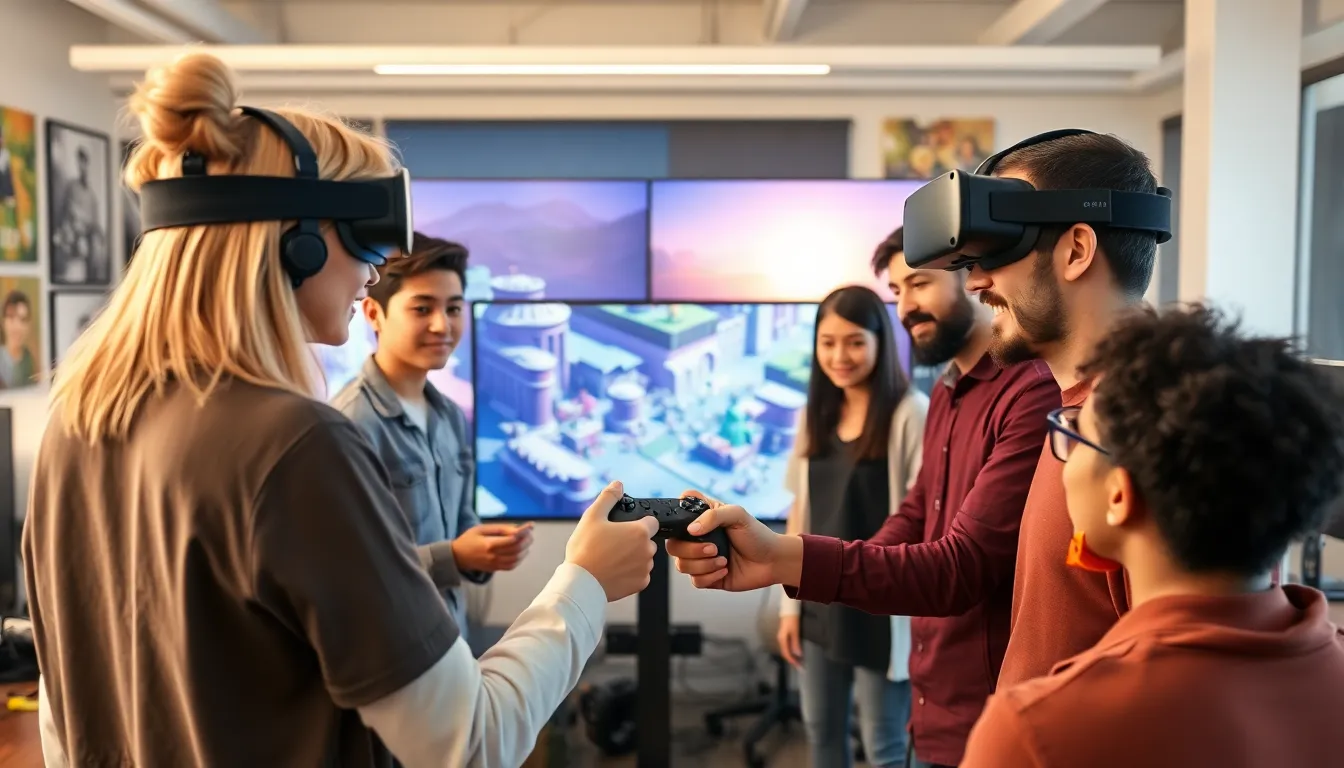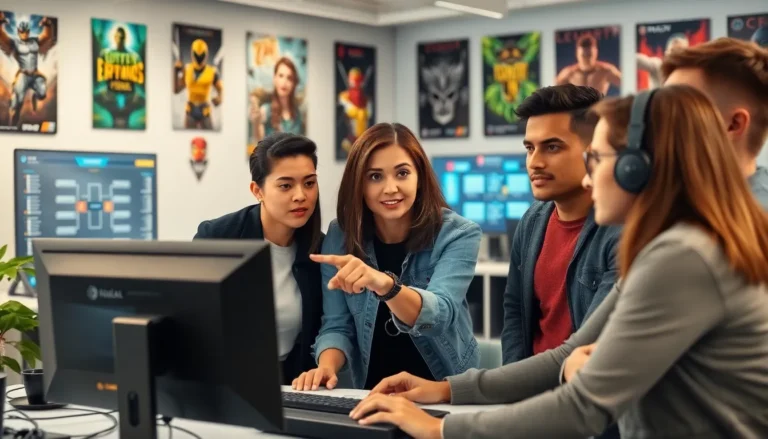Imagine slipping on a headset and diving into a world where dragons roam, space battles rage, and you’re the hero of your own epic saga. Virtual reality game development isn’t just about coding and graphics; it’s about crafting experiences that transport players to realms beyond their wildest dreams. With technology evolving faster than a speeding bullet, the opportunities for creativity are endless.
Developers are no longer bound by the limitations of traditional gaming. They’re pioneers, sculpting immersive environments that engage all senses. Whether it’s creating a serene landscape for meditation or a heart-pounding adventure through alien worlds, VR opens doors to uncharted territories. So buckle up and get ready to explore the thrilling world of virtual reality game development, where imagination meets innovation and every pixel holds the promise of adventure.
Table of Contents
ToggleOverview of Virtual Reality Game Development
Virtual reality game development encompasses a range of disciplines that blend technology and creativity. Developers utilize advanced tools to create immersive worlds where players engage in unique experiences. Game engines, such as Unity or Unreal Engine, serve as foundational platforms for building VR experiences.
Innovative design principles guide the creation of environments that react to player interactions. Specific techniques, like 3D modeling and animation, bring characters and settings to life in compelling ways. Code plays a crucial role, enabling responsive gameplay mechanics and realistic physics that enhance immersion.
Sound design contributes significantly to the overall experience. By incorporating spatial audio and ambient sounds, developers deepen players’ connection to the virtual environment. User interface design also receives careful consideration; intuitive controls ensure seamless navigation within the VR world.
Testing processes are critical in VR game development. Rigorous quality assurance helps identify glitches and enhance user experience before launch. Developers often rely on feedback from testers to refine gameplay and interactions, ensuring a polished final product.
Given the rapid advancements in technology, staying updated on the latest VR trends is essential. Emerging tools and techniques can redefine gameplay possibilities, making ongoing education important for developers. Understanding the market landscape, including key player preferences and industry demands, shapes effective development strategies.
Creativity drives innovation in this domain. The combination of technical skills and artistic vision leads to groundbreaking experiences that resonate with players. Virtual reality game development not only pushes boundaries but also establishes new paradigms in interactive entertainment.
Key Technologies in Virtual Reality

Virtual reality game development relies on several key technologies that enhance player experiences. These technologies shape immersive worlds and engaging interactions.
Game Engines
Game engines serve as the backbone of virtual reality development. Unity and Unreal Engine are leading choices among developers for their robust features. Both engines offer extensive libraries, enabling rapid prototyping and implementation of complex mechanics. Customization options allow developers to tailor experiences, while real-time rendering capabilities enhance visual fidelity. Each engine supports various VR platforms, ensuring that games reach wider audiences.
VR Hardware
VR hardware significantly impacts player immersion and interaction. Headsets like Oculus Rift and HTC Vive provide high-resolution displays and advanced tracking capabilities. Controllers facilitate intuitive interactions, allowing players to manipulate virtual environments seamlessly. Accessories such as haptic feedback devices add tactile sensations, deepening engagement. As hardware technology evolves, newer systems continuously improve responsiveness and comfort, further elevating the virtual reality experience.
Design Principles for VR Games
Designing for virtual reality centers on creating genuine immersion and enhancing user experience. Developers prioritize aspects like immersion and interface to engage players effectively.
Immersion and Presence
Immersion defines the degree to which players feel part of the virtual world. Effective VR experiences require seamless integration of visuals, sound, and interactions. Virtual environments should stimulate players’ senses, drawing them deeper into the gameplay. Creating realism in graphics and physics fosters a strong sense of presence. Players must feel as if they inhabit the virtual space, responding naturally to it. Successful implementation of spatial audio enhances this experience, making sounds seem to originate from specific directions. Developing environments that react to player actions increases engagement. Techniques like dynamic lighting and weather effects contribute significantly to immersion.
User Interface Considerations
User interface design plays a critical role in VR game development. Interfaces must be intuitive and non-intrusive to maintain immersion. Placing controls within the player’s natural line of sight simplifies navigation. Using hand tracking and gesture controls aligns interactions closely with players’ movements. Developers should ensure that elements like menus and inventories are easy to access without breaking immersion. Visual feedback reinforces player interactions, providing clarity in complex tasks. Consistency across UI elements minimizes confusion, allowing for a smoother experience. Prioritizing legibility and responsiveness in design creates a more welcoming environment for players.
Challenges in Virtual Reality Game Development
Virtual reality game development poses unique challenges that developers must navigate. These challenges significantly impact the creation of immersive and engaging experiences.
Technical Limitations
Technical constraints affect the overall quality of VR experiences. Hardware limitations can restrict graphics fidelity and processing capabilities, often leading to performance issues. Frame rates must remain high to prevent motion sickness and maintain immersion. Furthermore, creating realistic physics and interactions demands extensive resources. Networking challenges also arise in multiplayer settings, complicating synchronous interactions. Ensuring compatibility across various platforms requires additional development time and effort. Consequently, developers need to strike a delicate balance between ambition and feasibility.
User Experience Issues
User experience issues frequently complicate VR game development. Players’ comfort and usability hold paramount importance in designing intuitive controls and interactions. Designing menus that overlay seamlessly without breaking immersion proves challenging. Motion sickness remains a significant concern; developers must optimize movement mechanics to prevent discomfort. Additionally, differing user preferences create complexity in crafting universally appealing experiences. Balancing engaging narratives with accessible gameplay requires thoughtful consideration, as personal tastes vary widely. Prioritizing usability ultimately enhances player satisfaction and success in the marketplace.
The Future of Virtual Reality Game Development
Future developments in virtual reality game design promise to reshape interactive entertainment. Innovations continue to emerge, enhancing immersive experiences through advanced hardware and software. High-resolution displays and improved haptic feedback systems will redefine player interactions.
Emerging trends highlight the growing significance of social experiences in VR games. Developers increasingly focus on multiplayer functionalities, facilitating shared adventures among users. As players connect within these digital realms, the demand for seamless networked interactions rises.
Artificial intelligence is expected to transform gameplay dynamics significantly. AI-driven narratives and adaptive environments enhance player engagement, responding intelligently to user actions. Such integration fosters unique experiences tailored to individual preferences and playstyles.
Additionally, cross-platform compatibility emerges as a vital consideration for future game development. With diverse hardware options available, developers strive to ensure that players can interact regardless of platform. This inclusive approach bolsters user engagement and broadens market reach.
Sustainability in game development is gaining momentum, reflecting a broader industry trend. Emphasizing energy-efficient practices and eco-friendly materials resonants with environmentally conscious players. Developers increasingly incorporate these values into their creative processes, aligning with user expectations.
Fundamentally, the collaborative nature of VR game development requires input from various disciplines. Designers, artists, and programmers work in unison to create cohesive experiences. This teamwork continues to be instrumental in pushing the boundaries of what VR can achieve.
As the industry evolves, staying informed about technological advancements remains imperative. Understanding market demands and player preferences contributes to successful game releases. Insights gained from testing and feedback loops further enhance product quality and user satisfaction.
The landscape of virtual reality game development is rich with potential and innovation. As developers continue to push boundaries they create experiences that captivate players in ways traditional gaming cannot. The fusion of technology and creativity not only enhances immersion but also redefines how stories are told and shared.
With advancements in hardware and software the future of VR gaming looks promising. Collaboration among various disciplines ensures that every aspect of gameplay is optimized for user experience. As this dynamic field evolves staying ahead of trends and embracing new technologies will be crucial for developers aiming to leave their mark in the industry.





